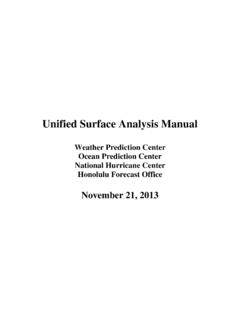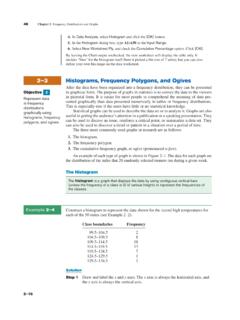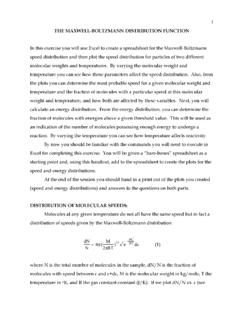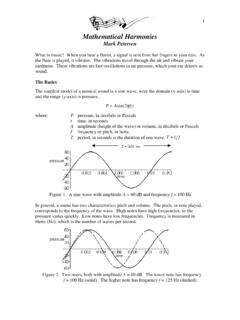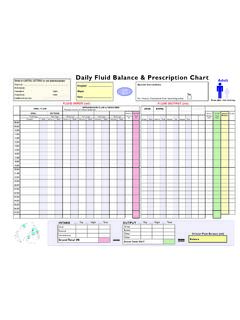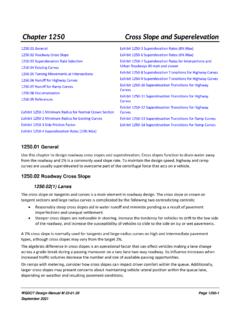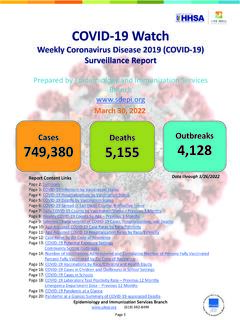Transcription of Snow forecasting - Weather Prediction Center
1 Snow forecastingHydro-meteorological Prediction CenterAnother inch with the vort!Snow forecasting Things to think about when forecastingsnow and snowfall amounts How to forecast precipitation type snowfall accumulations A few empirical forecast techniques Synoptic and mesoscale aspects of heavysnow Case studiesForecasting snow requires knowledge of the numerical models must resolve which model has best storm track knowledge of whether the pattern the model isforecasting favors a major snowstorm or a minorone. an assessment of whether the model is handlingthe mesoscale structure correctly. knowledge of the model low-level temperaturebiases. For example, the models often warm the low leveltemps too quickly across northern MaineTo forecast snowfall amounts1-- Need to forecast liquid equivalent (qpf)2-- Determine rain/snow line, precipitation type3-- Then determine whether surface temperature will allow snow to accumulate4-- Finally, predict snow to liquid equivalent ratioThe physical reasons thatdetermine the amount of snowthat falls over any location are The vertical transport of moisture into the system vertical motion and moisture The efficiency of the precipitation processes(cloud physics)
2 Size of the area of precipitating clouds Propagation, are new snow producing cloudsdeveloping upstreamPrecipitation type is dependent on the vertical temperaturestructure mechanisms that can change the verticalstructure include: evaporation melting thermal advection vertical motion solar radiation (especially during spring) Is dependent cloud physics (freezing rain vssnow)Traditional ways to forecastprecipitation type 1000 -500 thickness will not resolve thin warm layers warm boundary layer temperature or a warm layer abovethe surface 1000 -850 and 850-700 mb partial thicknessmethods better, but still may miss a very thin warm layer soundings and forecast soundings the best method1000-500 mb thickness5595545495445395345295245195141 000-500 THICKNESS (dm)6 12 182430364260544872 7866 STATION ELEVATION (HUNDREDS OF FEET)
3 50 % values of 1000 -500 mb thickness as a function of station elevationStrong marine influenceThe critical thickness varies with elevation and with the dominantweather regime (stability of the airmass) that affects the stationFigure adapted from Glahn et al., 1975 THE 50% CRITICAL THICKNESS FORMOUNTAINS OF UTAH1000-500 THICKNESS540550560570580 ELEVATION IN THOUSANDS OF FT45678910111213 HAYDEN PEAK (580)MT. TIMPANAGO (576)TWIN PEAK (575)OQUIRRH MTNS (570)SNOW BIRD (567)BRYCE CANYON (558)PARK CITY (TRAM) (565)CEDAR CITY (549)BLANDING (551)LOGAN (545)SILVER LAKE (563)OGDEN AND PROVO (544)MONTICELLO (554)VERNAL (547)SLC AIRPORT (543)Partial Thickness850-7001000-850<154<154<154 Precipitation TypesSignificant UVV orlow-level coldadvectionWeak UVV and nearzero low-level coldadvection>154>154>154<129129-131>131 Thickness (dm)Rain>131129-131<129 SnowSnow or sleet exceptmay be freezing rainnear 154, usually rainwith south winds inwarm sectorSnow, except sleetand/or freezing rain ispossible near 154 Sleet except may besnow near 154)
4 Sleet or snow except>152 usually freezingrain or drizzle, rain inwarm sector with southwindsFreezing rain but maybe sleet near 154 RainFreezing rain, freezingdrizzle or sleetRainAdapted from Cantin et al. 1990 Used for southeastern CanadaRainFreezing rain orfreezing drizzlePrecipitation type from soundingsThis is the best way to determine precipitation type Summary of important factors to look at onsounding how warm is warm layer what is the depth of the layer with wet bulbtemperatures above zero wet bulb temperature of cold layer depth of cold layerThe warm layer If Tw of warm layer exceeds 3 to 4o C, snow meltscompletely resulting in rain or freezing rain. If Tw is less than 1o C, only partial melting occursand snow will usually refreeze.
5 If Tw is 1-3o C usually results in partial melting ofsnowflakes but then usually refreezes into sleet (ora mixture of sleet and freezing rain depending onthe depth of the warm Stewart and King, 1987 Lower cold layer If temperature is less than -10oC, and freezingnuclei are sufficiently abundant and enough timeis spent in the cold layer, either snow or sleet canoccur. If cold layer is warmer than -8oC, droplets remainsuper cooled if the snow was completely melted(favors freezing rain). Depth of cold layer is not nearly as important asthe temperature of the cold Stewart and King, 1987A freezing rain soundingNote that temperature of the warm layer is above 4oC0otemperature10oAn ice pellet soundingNote temperature of warm layer is 1-3oC0o10otemperatureUnfortunately, a shallow warmlayer may show up on a forecastsounding.)
6 Use a combination offorecast soundings and MOSguidance to help predict the mostlikely precipitation RAIN OR SLEETTHE TAU TECHNIQUE - Cys et al., 19961012345678910002000300040005000 FREEZING RAINICEPELLETSMEAN LAYER TEMP (CO)LAYER DEPTH (M)FROM SOUNDING1. IDENTIFY DEPTH OF WARM LAYER (ABOVE 0OC)2. IDENTIFY THE MEAN TEMPERATURE OF THE WARM LAYER 3. THEN , FIND COORDINATE ON THE chart ABOVE,THE YELLOW AREA USUALLY GIVES FREEZING RAINWHILE THE WHITE AREA GIVES SLEETF reezing drizzle Bocchieri (1980) and Young (1978)found that 30% and 40% of freezingrain (usually drizzle) did not have alayer that was above freezing on thesounding. Huffman and Norman (1988) notesfor this type of freezing rain eventcloud top temperatures within thelow- level cloud deck should be inthe 0o to -10oC range and that thereshould be a pronounced dry layerjust above the cloud top.
7 A typicalsounding for freezing drizzle layer0-20-10900800700600500 Pressure (mb)Temperature (oC)Sounding from Rapid City, SD at 00 UTC 12 March1976. Temperature (red line), dewpoint (dashed), frostpoint (blue dots).dry layerNCEP ETA PRECIPITATION TYPEALGORITHMBLUE SHADED AREA IS WHERE MODEL SOUNDING SUGGESTS SNOW,VIOLET WHERE IT INDICATES SLEET AND RED FREEZING RAIN, DARKERBLUE LINES INDICATE Rh, WHITE LINES INDICATE VERTICAL intensity The rate that snow falls is a function of rate of growth of a single crystal which peaks around -15oC and the number of crystals per unit volume, the number can be increased by fragile crystals (dendrites and needles) fracturing by ice splintering during riming fragmentation of large super-cooled drops during freezingWhen cloud top temperatures are -25oC or colder theconcentration of ice particles is usually sufficient to use up allthe condensate in stratiform and orographic cloudsICE CRYSTALS GROW BY250200150100 500-2 -4-6-8 -10 -12 -14 -16 -18 -20 -22150 sec100 sec50 secTEMPERATURE (Co)MASS (10-9g)--Deposition, because esw>esi , vapor is transported from--By collisions between super-cooled cloud drops and ice crystalsExperimentally determined variation of the mass of ice crystals growing bydiffusion of vapor in a water saturated environment, as a function of growth timeand temperature.
8 (From Ryan et al., 1976; by courtesy of the AmericanMeteorological Society, and the authors.)droplets to ice crystalsThe variation of crystal habit with temperature and supersaturationaccording to the experiments of Mason et PRISMS FAST GROWING DENDRITESPLATESS upersaturation with respect to ice (percent)01020304050 Temperature-10-20-30-40 Water-saturationSECTOR PLATESSECTOR PLATESHOLLOWNEEDLESSECTOR PLATESTHICK PLATESPRISMSSOLID PRISMSOLID VERY THICKPLATESCUPSSOLID PRISMSDENDRITESSNOWFLAKE SIZE IS ALSO DEPENDENTON AGGREGATION*MULTIPLE ICE PARTICLES FORM MAIN SNOWFLAKE*AGGRAGATION PROCESS IS MAXIMIZED AS TEMPERATURE APPROACHES 0oC70605040302010-15-10-50 DOMINANT CRYSTAL TYPEPLANAR DENDRITICRADIATING ASSEMBLAGET emperature (oC)Maximum snowflake diameter (mm)
9 Maximum observed snowflake diameters as a function of air temperaturefor two types of snowflake compositions. (From Rogers, 1974, 1974b)WHY SHOULD I CARE ABOUT THE PHYSICALCHARACTERISTICS OF THE SNOWFLAKES The dominant crystal type may affect the snow to liquidequivalent ratio (how fluffy the snow is). Unrimed Dendritic and plate crystals have a lacy structures thatusually produce the highest snow to liquid ratios (bestaccumulators) The make-up of the cloud may affect the snow to liquid there is abundant liquid water in cloud causing crystals togrow by riming, snow to liquid ratios are lower (may be 10 to 1 orlower) Cloud physics effect how efficient the system is atproducing snowflakes. Dendrites crystals grow fastest. The size and composition of the snowflake may helpdetermine how quickly it sticks on the ground whentemperatures are marginal for snowfall accumulations.
10 Large aggragates may take longer to melt than smaller snow to liquid ratioSummary Warm ground and boundary layer temperatures can keep snow-waterratios down a warm layer that approaches zero oC also will usually keep the ratioslow. Storms having clouds with a large amounts of supercooled dropletswill not have as high a ratio as storms in which most crystal growth isby deposition. Soundings that are almost isothermal with a large portion of thesounding near zero oC will usually have a ratio of 8 or 10 to 1. Deep cold air promotes higher ratios but if the temperatures are toocold the crystal type may not be conducive to high ratios.. Storm tracks often provide keys to forecasting the snow to water ratio tracks near oceans have more liquid water in clouds which usuallyproduces lower snow-liquid ratiosFor exampleSouthern storm tracks typically are associated lowersnow to liquid ratios than clipper type systemsRATIO8-1 SNOW-WATER20-1 SNOW-WATER RATIO6-1 SNOW-WATER RATIO,SNOW MAY MIX WITH RAINOR SLEETAVERAGE SNOW-WATER RATIOS FORFOR SOUTHEASTERN WISCONSIN WITHVARIOUS STORM TRACKSA dapted from Harms, 19701) Northern storm tracks that favorsnow crystal growth by depositionfavor high snow-water ) When ice crystals grow by riming orcrystals colliding with supercooleddroplets, the snow-water ratios )
